The latest in the endless stream of books about the Kelly story has just come to my attention. It’s a photographic travel guide, only the third that I have seen, the other two being the elegant “Photographic Journey” by Brendan Kelson and John McQuilton, and the hopeless and forgettable “Introduction to Ned Kelly” by Jack Peterson. This new book refers a number of times to a fourth travelogue, one I hadn’t heard of before called “In search of Ned” by Kevin Passey, from 1988. Its photos are all in black and white; AbeBooks lists a copy available for $150! so I might give that one a miss.
‘A Journey Through Kelly Country’ describes itself is “an essential travel guide that will lead you on an amazing journey of discovery through Kelly Country. The guide is full of maps and step-by-step directions on how to locate these historic sites. Photographs show you their past and present condition. You will be lead to historic sites that, although not so well known, are still important to the Ned Kelly story.” It is available as an e-book for $19.95 or as a paperback for $39.95 (HERE) I would like to have known the dimensions of the paperback edition – if it was big enough it could be quite a lovely book to look at, because as I quickly discovered on the e-book that I purchased it contains some really lovely photographs of Kelly country.
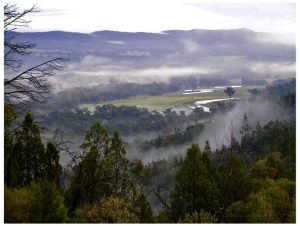
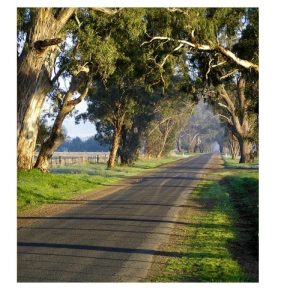
I’ve not been able to test on the ground how well this new book works as an actual travel guide, but reading the book, and the instructions and maps that are provided to show you how to find just about any Kelly related historical site in the Kelly Country, I get the impression that this surprisingly comprehensive Guide is brilliant. There are around sixty different sites described and photographed, each with detailed instructions on how to find them. The directions and the maps seem clear, and there is also advice about public accessibility in relation to each site, clearly indicating which places can be approached and which ones can’t because they are on private land. There are even GPS co-ordinates for a cave site up in the hills of the Woolshed Valley, for enthusiasts willing to do a bit of hiking.
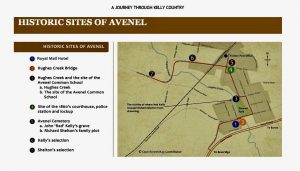
The photos in this book are high quality and many are quite artistic and beautifully taken. There are also historical photos of places that have since disappeared, a few old maps and photos of some original Kelly documents making the book suitable for the armchair traveller as well as the actual traveller.
There is however a serious downside to this book in the skeletal Kelly narrative that it supplies to accompany the photos. Given that the Kelly story by every reckoning is at least controversial, and the ‘hero-or-villain-you-decide’ mantra is still a popular refrain in the Kelly world, I would have thought the author, Anthony Dodd should have made the effort to be neutral, to resist the urge to advocate for one side and just stick to the undisputed evidence, but regretfully he hasn’t done so. Instead the travelogue seems to be a vehicle to subtly promote his obvious pro-Kelly position, and sanitise the nasty realities of the Kelly outbreak. For example, he recounts a very skewed and kelly-favourable version of the ‘Ah Fook’ incident, and writes that before visiting the Kelly house, Constable Fitzpatrick had “a few drinks”. This description is not only false but plays to the Kelly myth that Constable Fitzpatrick was a drunk. There is ZERO evidence of this. In fact all that is known about drinks are the word of Fitzpatrick himself who said he had not ‘a few’ but a single drink of brandy and lemonade. Another example of pro-kelly bias is the statement in relation to Stringybark Creek that “the first exchange of gunfire led to the death of Constable Thomas Lonigan” which plays to the Kelly myth that the policemen were killed in some sort of fair fight between police and gang members. In fact even Ned Kelly said that Lonigan didnt actually fire his weapon, so to say there was an exchange of gunfire is simply incorrect. To then say that “the second exchange of gunfire led to the deaths of (Scanlon and Kennedy)” again plays to the Kelly myth about what happened and also creates a completely false picture of the reality of how these two policemen were brutally killed. In a similar fashion, he ignores the negative detail of Jim Kellys arrest in NSW for horse stealing, his adoption of a false name and the violent way in which he resisted arrest, he ignores the horrors the gang had planned for Glenrowan and mentions only that there was a plan to derail the Special Police train, he provides an unnecessary partisan but very shallow view of Irish history and of the relationships between squatters and selectors in Australia, and generally has presented a sanitised and sympathetic view of Ned Kelly and the outbreak. The bibliography lists all the usual pro-kelly authors from Jones to McMenomy, Corfield and Kenneally, but not one from the new wave of Kelly scholars like MacFarlane, Morrissey, Kieza or Dawson whose insights into the outbreak should now be starting to appear as sources in new Kelly books. I can’t believe that Dodd wasn’t aware of these authors, as he claims to have had an interest in the Kelly story for many years, so I am disappointed to conclude he must have done what Peter Fitzsimons did when he wrote his Kelly book five years ago, bury his head in the sand and deliberately ignore the new works.
The narrative therefore badly lets the rest of the book down, because like it or not the old Kelly myths are being put to bed, and I think Anthony Dodd should have pared the ‘narrative’ back to the barest facts and made the book a pure travelogue, a book about the Kelly places rather than the Kelly story. I think he should have left readers to make up their own minds about the true story rather than try to influence them with his personal bias and the inevitable errors that he has included.
Having said all that, it’s clear this book will be an excellent travel guide to Kelly Country, and the excellent photos might just persuade everyone who thinks they can’t get there to see these sites for themselves to make the effort. For $20 as a download onto your i-pad it’s well worth it.
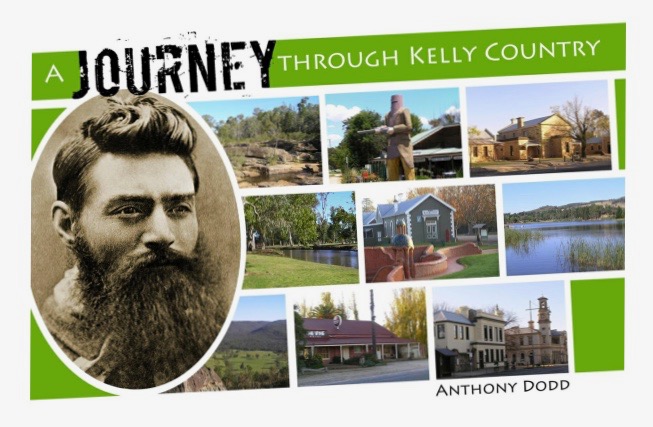
Hi Dee, thanks for writing this Dodds book up, I had not heard of it. It sound much better photo-wise than another, small, “picture tour” book, “Ned Kelly Country” by Greg Powel (Brown and Associates, Qld, 1977), which is basically a 32 page colour A4 booklet in a glossy light card colour cover. It has an assortment of photos including shots of the author’s two kids clambering about hills in “Kelly country”, and a number of photos of actors dressed up as either the Kelly gang or uniformed police… The text is of course pro- Kelly gang, and being 1997 there is barely a critical word in it. No travel maps, references or sources, and the usual old rubbish about Fitzpatrick, Stringybark Creek, and Ned getting through the police line after he saw Byrne shot, i.e. after 5 in the morning, which as I showed in my Republic myth book, is entirely due to Ian Jones completely bungling the story by relying on two mistaken recollections 30 years later, by Dwyer and Sadlier, in direct contradiction to plentiful contemporary evidence that Ned escaped from the Inn about 3.30am just before the police finished surrounding the Inn, never returned to it again, collapsed in the bush, got up at dawn and commenced his last stand.
Most Kelly books are going to be pro-Ned, especially travel books, as their market is people interested enough in the Kelly story to want to go travelling through and see where it happened. This however, is relatively few people. In most “Kelly sites” there is nothing to see. You can, if you catch a Beechworth Kelly tour, see the bit of field where Aaron Sherritt’s hut once was, for example. It might as well be a bit of scrub anywhere. You can see the bit of land behind what may have been the place where the pub once stood where Ned is supposed to have fought Wild Wright. There is nothing there at all, and the land is exactly the same as the rest of the strip of land running along for a hundred metres or so. You can go to Stringybark Creek, and if you didn’t know what happened there re the murder of the police, there is nothing whatsoever to distinguish that bit of bush from any other bit of bush for a couple of miles around. You can go to Power’s Lookout, where after much clambering about you stand on some rocks with a great view of the King Valley, but no different to any of several outcrops in the same area. What makes the difference is only the feeling that something historic happened at some spot or other. It is imaginary; there is nothing to see, and no ghosts. And once you realise or come to learn that most of what has been written about the Kelly story is unhistorical, romanticised nonsense, the gloss wears off pretty quick. I might do my own Kelly country travel book one day, with text about what actually happened at each site. That might wake a few people up!
Thanks Stuart. You are right, place has no relevance to history. If you want to see where something Kelly-related actually happened, it is better to just go and pick any paddock and pretend it was there. Just make sure you have one of Stuart’s articles because he is excellent at telling us what is truth and what those nasty myth-makers have concocted.
Hi Ron, thanks for the moral support! I won’t go as far as agreeing that place has no relevance at all to history, as for example the Old Melbourne Gaol or Port Arthur are sites where certain things happened in built structures; but if you are referring to bush places or vanished sites, which is what I was thinking of, then certainly yes, you might as easily sit almost anywhere and make it up. Another example is Jerilderie, where a walking trail with signs taken from text by Ian Jones gives highly distorted snippets of the Jerilderie raid story, which is basically, “we were stuck up by a gang of thugs a long time ago”. The endlessly recycled rubbish about what daring-do the gang displayed is given, with no mention of Mrs Devine being marched to the church by Dan Kelly poking her in the back with his revolver while threatening to kill her husband if she disobeyed, etc. At least Grantlee Kieza’s book “Mrs Kelly” does not hide the evil criminality that was front and centre of practically everything the gang did, although he does go fairly soft on Mrs Kelly herself. The fact that the small town of Jerilderie had quite a few strangers hanging around before, during and after the robbery is not mentioned in pro-Kelly stories, but as noted in the Jerilderie paper of the day, explains much about the intimidation felt by the townsfolk. There are more signs on vacant lots saying the such-and-such happened in this place during the Kelly gang raid, than there are on actual places to see. It took me less than 3 hours to cover everything Jerilderie had to offer a Kelly tourist, and most of that was not much at all.
Thanks Stuart. I have picked out a likely paddock which is only two miles from my place. I will visit it tomorrow and mark it as the place of Sherritt’s hut. I don’t know what we would do without your great wisdom on Kelly matters.
Hey Ron why not calm down, read the new travel guide and tell us what you think! I would be interested to hear if anyone disagrees with me about the narrative – the bits about Stringybark Creek and Lonigan being killed in an ‘exchange of gunfire’ really shouldn’t be accepted. The author could have just done the Travelogue bit and ended up with a great production that everyone would have been happy with.
Maybe Jack has done a photography course and changed his name?
(And don’t allow any more comments from “Ron” who thinks he is funny and clever.
He ain’t!
Yes David. I would like to read this book, it sounds intriguing. Sorry Anonymous, I am not sure what you are trying to suggest.
For anyone who is interested, my new site of Sherritt’s hut is at 37° 19’ 53.13” S 145° 01’ 09.17” E. It is north-facing with some rugged land not far away. Much closer to Melbourne and the Hume Highway, so may be more convenient for many people than having to go all the way to the Woolshed Valley. I know this will not be for everyone, but I think it’s a nice idea. Would love to hear everyone’s thoughts. I have placed a small laminated sign on the gum tree in the centre but would like to organise something better for future visitors.
Great idea! And lets have a 3D virtual reality tourist activity where they can watch Joe shooting Aaron through the throat and bleeding out on the floor with his wife and mother-in-law screaming and crying, and then have Joe and Dan and then a few kelly yahoos hanging around yelling at the police inside to come out, and maybe even have an optional extra that shows what would have happened if they DID come out – ie get murdered. Time to show the real story!
So heres a photo of the exact site you mention from Google Street View – its six or seven miles north from Wallan
Attachment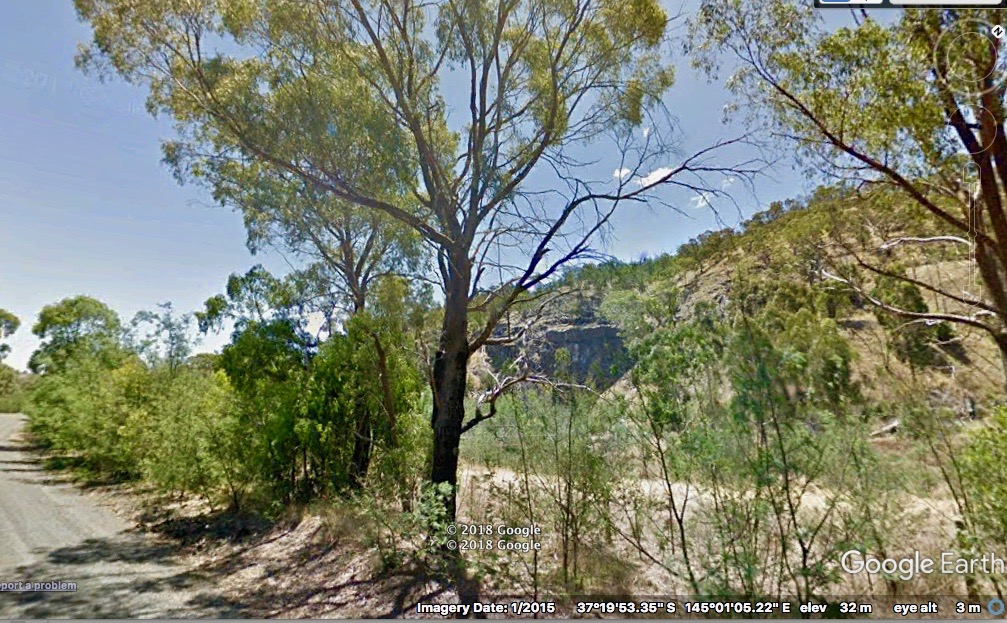
Heres the Google Earth view
Attachment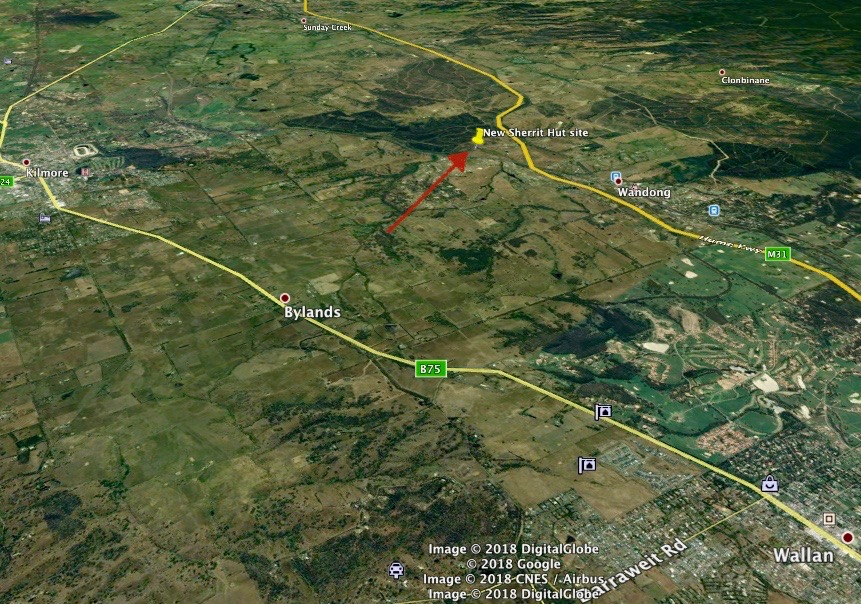
That’s all good fun, I suppose, but has nothing to do with understanding history. My point was simply that many sites on the “Kelly trail” contribute equally noting to understanding history. Of course, others will likely not agree, possibly because they attach significance to places that are now no more than a geographical location long overgrown by bush, or bulldozed to the ground, or rebuilt over with new structures that have nothing to do with past historical events – such as the replacement bank building in Euroa that stands on the site of the bank the Kelly gang robbed long ago. There is a plaque on the wall telling you so. So answer this, if anyone can be bothered: does going to a place where an event happened long ago, in a geographically knowable spot which has since been totally obliterated except for old photographs, add anything at all to the understanding or appreciation of history? In my view, no. But others may not agree; they may think for various reasons that just going to such a now obliterated place does contribute something to their appreciation of history. In which case, good on them, I say, and I hope they have a nice walk, lunch, coffee, or whatever, and enjoy their day out. I don’t expect everyone to agree with how I look at such obliterated sites. Tread your own path!
It’s a happening town, Jerilderie
Attachment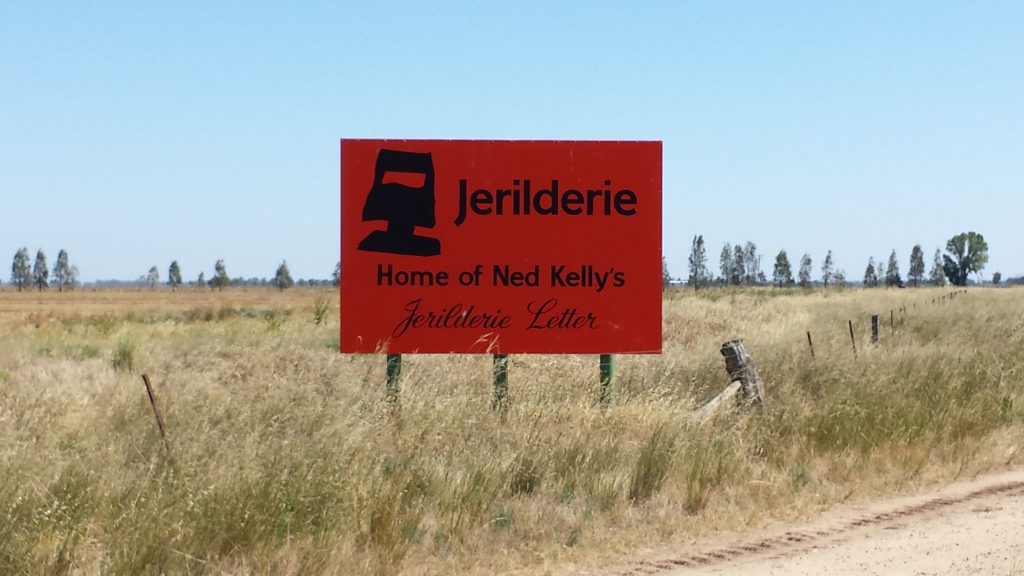
The Sherrett hut was on the Devil’s Elbow at Sebastopol, Beechworth. From there the small Police party nightly was led by Aaron Sherrett to a spot overlooking the Byrne household. Any other place for the Sherrett hut has impossible logistical problems.
Nice try, Ron. We all have the MacFarlane book. You don’t, it seems…
The point is still being missed about place and history. There is an importance about the place where the police were murdered by ambush at Stringybark Creek; the place where Kennedy was executed; the path he likely took from the ambush to that place, etc. The government have refused to honour these places with correct signage. So these events could have happened anywhere in a couple of miles radius, for all a tourist can tell. In other words, the most momentous event in the Kelly outbreak, that turned the gang into outlaws, is not recognised by precise and historically accurate signage despite being identified, while places that have been totally obliterated have been commemorated by the same official funding bodies. Isn’t is obvious that there is something massively wrong here?
Anonymous, a paddock is a paddock is a paddock, as Stuart has previously explained. That is the beauty of all this.